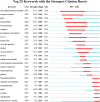A Bibliometric Analysis of Microneedle-Mediated Drug Delivery: Trends, Hotspots, and Future Directions
- PMID: 40376038
- PMCID: PMC12079042
- DOI: 10.2147/DDDT.S519048
A Bibliometric Analysis of Microneedle-Mediated Drug Delivery: Trends, Hotspots, and Future Directions
Abstract
Purpose: Microneedles can physically penetrate the stratum corneum, creating micropores on the skin, and allowing for drug delivery through direct diffusion, injection, or other methods. As a novel drug delivery method, it possesses significant application potential. This study uses bibliometric analysis to explore the research hotspots and development trends of microneedle-mediated drug delivery.
Methods: Relevant research articles on microneedle-mediated drug delivery published between 1998 and 2024 in the Web of Science Core Collection (WoSCC) database were retrieved. Data analysis and visualization were performed using VOSviewer, CiteSpace, Scimago Graphica, and Pajek, enabling the prediction of research trends in microneedle-mediated drug delivery.
Results: In general, research on microneedle-mediated drug delivery has shown a continuous increase. China and the United States are the leading countries in this field of study. Notably, Ryan F. Donnelly (n=224) is the most prominent contributor to this field. The current core research directions include: disease treatment, enhancement of transdermal absorption performance of microneedles, vaccine delivery, and new materials and technologies for microneedle manufacturing.
Conclusion: Microneedle-mediated drug delivery, as a novel technology and method, holds significant research value and application potential. However, further strengthening of international collaboration and the clinical translation of research findings are needed.
Keywords: materials science; percutaneous drug delivery; research trends; vaccine delivery.
© 2025 Xiang et al.
Conflict of interest statement
The authors report no conflicts of interest in this work.
Figures













Similar articles
-
Research hotspot and trend of microneedles in biomedical field: A bibliometric analysis from 2011 to 2020.Burns. 2022 Jun;48(4):959-972. doi: 10.1016/j.burns.2022.04.004. Epub 2022 Apr 22. Burns. 2022. PMID: 35504768
-
Current trends in polymer microneedle for transdermal drug delivery.Int J Pharm. 2020 Sep 25;587:119673. doi: 10.1016/j.ijpharm.2020.119673. Epub 2020 Jul 30. Int J Pharm. 2020. PMID: 32739388 Free PMC article. Review.
-
Recent advances in microneedle-based drug delivery: Special emphasis on its use in paediatric population.Eur J Pharm Biopharm. 2019 Mar;136:48-69. doi: 10.1016/j.ejpb.2019.01.005. Epub 2019 Jan 8. Eur J Pharm Biopharm. 2019. PMID: 30633972 Review.
-
Microneedle-mediated transdermal nanodelivery systems: a review.Biomater Sci. 2021 Dec 7;9(24):8065-8089. doi: 10.1039/d1bm01249e. Biomater Sci. 2021. PMID: 34752590 Review.
-
Hollow microneedles: A perspective in biomedical applications.Int J Pharm. 2021 Apr 15;599:120455. doi: 10.1016/j.ijpharm.2021.120455. Epub 2021 Mar 4. Int J Pharm. 2021. PMID: 33676993 Review.
References
-
- Henry S, McAllister DV, Allen MG, Prausnitz MR. Microfabricated microneedles: a novel approach to transdermal drug delivery. J Pharma Sci. 1998;87(8):922–925. - PubMed
Publication types
MeSH terms
LinkOut - more resources
Full Text Sources
Research Materials

